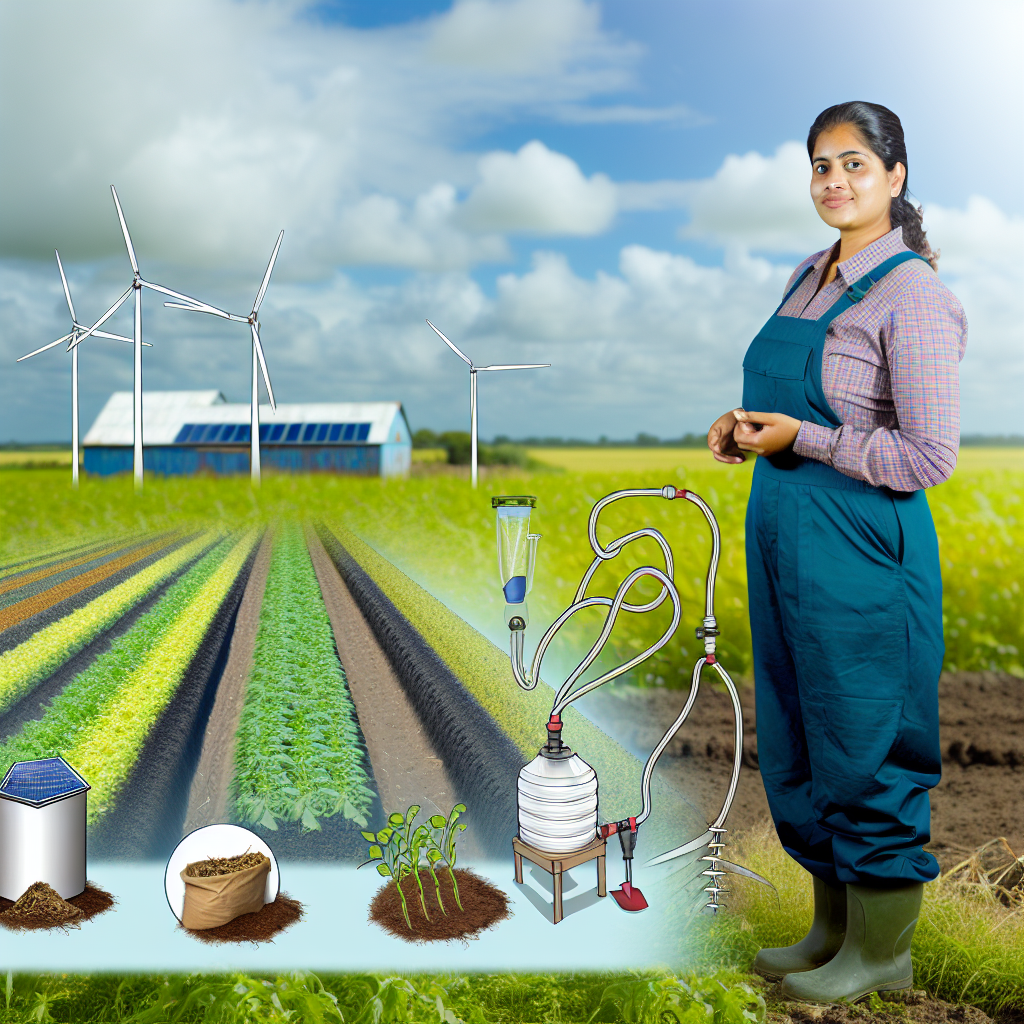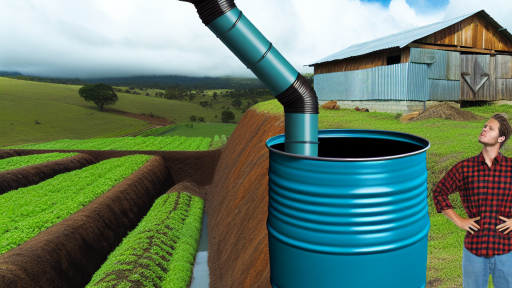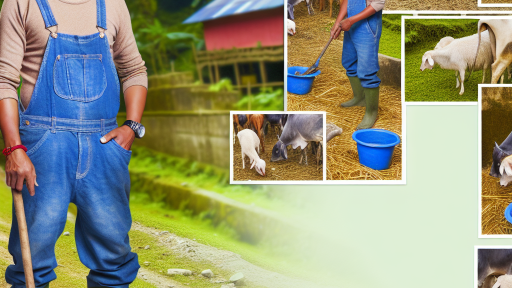Introduction to Carbon Sequestration in Agriculture
Carbon sequestration plays a crucial role in mitigating climate change.
It involves capturing and storing carbon dioxide from the atmosphere.
Agriculture offers unique opportunities for effective carbon sequestration.
This approach not only enhances soil health but also boosts agricultural productivity.
Understanding Carbon Sequestration
Carbon sequestration refers to the process of capturing atmospheric carbon.
It predominantly occurs in the soil and vegetation, especially in forests and grasslands.
Farmers can utilize various techniques to promote this process.
These techniques can transform agricultural practices into more sustainable approaches.
Benefits of Carbon Sequestration in Agriculture
Implementing carbon sequestration brings multiple benefits to farms.
First, it improves soil fertility by enhancing organic matter content.
Second, it helps in reducing greenhouse gas emissions.
Third, this practice provides a source of income through carbon credits.
Moreover, it promotes biodiversity within ecosystems.
Methods of Carbon Sequestration
Farmers can adopt various methods to enhance carbon storage.
- Cover cropping protects soil and adds organic matter.
- No-till farming minimizes soil disturbance and reduces erosion.
- Agroforestry integrates trees with crops, capturing more carbon.
- Composting enriches soil while trapping carbon in organic materials.
Real-World Examples
Many farmers have successfully implemented carbon sequestration methods.
Transform Your Agribusiness
Unlock your farm's potential with expert advice tailored to your needs. Get actionable steps that drive real results.
Get StartedFor instance, Amelia Carter runs a sustainable farm in Ohio.
She uses cover crops and reduced tillage for maximum carbon capture.
Similarly, GreenField Farms in California utilizes agroforestry techniques.
These practices contribute significantly to their sustainability goals.
Understanding the Science Behind Carbon Sequestration
What is Carbon Sequestration?
Carbon sequestration is the process of capturing carbon dioxide from the atmosphere.
This process helps reduce greenhouse gases in the environment.
Plants, soils, and oceans all play significant roles in carbon sequestration.
Mechanisms of Carbon Sequestration
There are two primary types of carbon sequestration: biological and geological.
Biological sequestration occurs through natural processes in ecosystems.
For example, plants absorb carbon dioxide during photosynthesis.
Then, they store the carbon in their biomass and soils.
Geological sequestration involves storing carbon in underground formations.
Specific methods include injecting carbon dioxide into depleted oil and gas reservoirs.
These geological formations can hold carbon safely over long periods.
The Importance of Carbon Sequestration in Agriculture
Agricultural practices can enhance carbon capture through sustainable methods.
For instance, regenerative farming techniques improve soil health.
Healthy soils can store more carbon than degraded soils.
Additionally, cover cropping and reduced tillage promote greater carbon retention.
Challenges and Considerations
While carbon sequestration is vital, it has some challenges.
For instance, land-use change can negate sequestration efforts.
Moreover, measuring the exact amount of carbon sequestered can be complex.
Farmers and policymakers must work together to address these challenges.
Future Perspectives
As we move forward, carbon sequestration will play a crucial role in climate strategies.
Integrating this process into farming will enhance sustainability.
Showcase Your Farming Business
Publish your professional farming services profile on our blog for a one-time fee of $200 and reach a dedicated audience of farmers and agribusiness owners.
Publish Your ProfileMoreover, ongoing research will improve techniques for maximizing carbon capture.
Ultimately, such efforts contribute to a healthier planet for future generations.
Benefits of Carbon Sequestration for Farm Sustainability
Enhancing Soil Health
Carbon sequestration improves soil health significantly.
It increases organic matter levels in the soil.
Higher organic matter enhances nutrient retention.
This leads to improved crop yields over time.
As a result, farmers can reduce the need for synthetic fertilizers.
Mitigating Climate Change
Carbon sequestration plays a crucial role in combating climate change.
By capturing CO2, it helps lower greenhouse gas concentrations.
This action aids in stabilizing global temperatures.
Farmers can contribute to climate mitigation strategies.
Promoting Biodiversity
Implementing carbon sequestration fosters biodiversity.
Diverse ecosystems support various plant and animal species.
Healthy ecosystems are more resilient to pests and diseases.
Farmers benefit from natural pest control mechanisms.
Economic Benefits
Carbon sequestration brings several economic advantages.
Farmers can access government incentives and programs.
This often includes grants for sustainable practices.
Moreover, carbon credits can provide new revenue streams.
Long-term sustainability leads to lower operational costs.
Building Community Resilience
Carbon sequestration strengthens community resilience.
It encourages local food systems and sustainable practices.
Increased collaboration among farmers enhances knowledge sharing.
Communities benefit from healthier food systems.
Ultimately, stronger communities improve local economies.
Gain More Insights: Drought-Resistant Crops for Sustainable Farming
Techniques for Carbon Sequestration in Crop Production
Cover Cropping
Cover cropping enhances soil structure and nutrient content.
These crops grow during off-seasons and protect the soil.
Additionally, they help in capturing carbon dioxide from the atmosphere.
Farmers can use legumes to fix nitrogen, promoting healthy soils.
Furthermore, deep-rooted covers increase soil organic matter.
Reduced Tillage
Reduced tillage preserves soil structure and minimizes disturbance.
It helps in maintaining carbon stocks within the soil profile.
This technique decreases soil erosion and promotes microbial life.
Moreover, fewer passes over the field reduce fuel consumption.
Farmers can save time and resources through this method.
Agroforestry
Agroforestry integrates trees into agricultural systems.
These trees store carbon and provide additional income sources.
Furthermore, they enhance biodiversity and improve ecosystem services.
This practice also helps in windbreaks and soil conservation.
Showcase Your Farming Business
Publish your professional farming services profile on our blog for a one-time fee of $200 and reach a dedicated audience of farmers and agribusiness owners.
Publish Your ProfileFarmers can create mixed systems for diversified outputs.
Soil Amendments
Applying organic amendments increases soil carbon content.
Compost and manure enhance soil fertility and microbial activity.
These additions help retain moisture and reduce nutrient leaching.
Healthy soils can sequester more carbon over time.
Farmers should consider regular amendments for long-term benefits.
Crop Rotation
Crop rotation prevents depletion of soil nutrients.
It introduces diversity in root systems, enhancing soil health.
Different crops also affect soil microbial communities positively.
This practice contributes to carbon sequestration by varying biomass inputs.
Farmers can observe improved yields and disease resistance.
Gain More Insights: Water Conservation Tips for Climate-Smart Farmers
Role of Agroforestry in Enhancing Carbon Storage
Introduction to Agroforestry
Agroforestry combines agriculture and forestry practices.
This method enhances farmland sustainability.
It also improves biodiversity by providing habitats.
Above all, agroforestry serves as a natural carbon sink.
Mechanisms of Carbon Sequestration
Plants absorb carbon dioxide during photosynthesis.
Roots store carbon in the soil, promoting soil health.
Additionally, trees provide long-term carbon storage.
Thus, agroforestry captures and retains carbon effectively.
Benefits of Agroforestry Practices
First, agroforestry improves soil quality.
Healthy soil enhances agricultural yields over time.
Second, it helps increase water retention in the soil.
This reduces the need for chemical fertilizers.
Moreover, it provides shade and reduces heat stress for crops.
As a result, farmers witness improved resilience against climate change.
Integrating Agroforestry into Farming Systems
Farmers can design agroforestry systems tailored to their land.
They can select appropriate tree species for compatibility.
Moreover, diverse crops can thrive alongside trees.
This diversity maximizes land productivity and carbon storage.
Case Studies and Success Stories
In Kenya, farmers practice alley cropping with tree rows.
This method has increased soil carbon significantly.
Similarly, in Brazil, mixed silvopastoral systems enhance carbon capture.
These successful implementations demonstrate the viability of agroforestry.
Future Directions and Considerations
Farmers should adopt agroforestry practices widely.
Investment in research can enhance implementation strategies.
Furthermore, collaboration among stakeholders is essential.
Ultimately, agroforestry will play a key role in combatting climate change.
Discover More: Soil Management Practices to Decrease Emissions
Integrating Livestock Management with Carbon Sequestration Practices
Understanding the Role of Livestock
Livestock can significantly influence carbon sequestration efforts.
Showcase Your Farming Business
Publish your professional farming services profile on our blog for a one-time fee of $200 and reach a dedicated audience of farmers and agribusiness owners.
Publish Your ProfileThey contribute organic matter through manure and plant residues.
This organic matter enhances soil health and stability.
Additionally, healthy soils store more carbon over time.
Implementing Rotational Grazing
Rotational grazing is an effective practice for carbon sequestration.
This method involves moving livestock between pastures frequently.
It prevents overgrazing, allowing grass to recover and grow.
Furthermore, healthy grasslands sequester more carbon dioxide.
Utilizing Agroforestry Techniques
Agroforestry integrates trees and shrubs into livestock systems.
These plants capture carbon through photosynthesis.
They also provide shade and forage for livestock.
This collaboration fosters a diverse ecosystem on the farm.
Promoting Soil Health through Cover Crops
Cover crops are vital for enhancing soil health.
They protect the soil from erosion and nutrient loss.
Furthermore, cover crops improve soil structure and microbial activity.
Using cover crops boosts carbon storage in the soil.
Enhancing Nutrient Management
Effective nutrient management supports carbon sequestration.
It reduces excess nitrogen runoff that can harm ecosystems.
Applying organic fertilizers helps build soil organic matter.
This practice increases the soil’s capacity to sequester carbon.
Monitoring and Assessing Impact
Regular monitoring helps evaluate the effectiveness of practices.
Farmers can measure soil carbon levels over time.
Using tools like soil tests can provide valuable insights.
This data enables informed adjustments to management strategies.
Collaborating with Local Experts
Farmers should seek guidance from local agricultural experts.
Cooperatives and agricultural extension services offer valuable resources.
They can help develop tailored carbon sequestration plans.
Partnerships enhance the likelihood of successful implementation.
Delve into the Subject: Optimizing Irrigation Practices for Carbon Sequestration

Monitoring and Measuring Carbon Sequestration on Farms
The Importance of Carbon Sequestration
Carbon sequestration reduces greenhouse gases in the atmosphere.
This practice significantly mitigates climate change effects.
Farmers can enhance soil health through effective carbon storage.
Methods for Measuring Carbon Sequestration
Various methods exist to measure carbon sequestration on farms.
Soil sampling provides direct measurement of carbon levels.
Farmers can also utilize remote sensing technology.
This technology offers a broader view of carbon dynamics.
Using Soil Sampling Techniques
Soil sampling is a foundational method for measurement.
Farmers should conduct tests in different soil layers.
These tests assess organic carbon content over time.
Regular sampling produces reliable data for farmers.
Leveraging Remote Sensing Technology
Remote sensing enables farmers to monitor large areas efficiently.
Showcase Your Farming Business
Publish your professional farming services profile on our blog for a one-time fee of $200 and reach a dedicated audience of farmers and agribusiness owners.
Publish Your ProfileIt helps track changes in vegetation and soil conditions.
Using satellite imagery increases measurement accuracy.
This technology provides real-time insights into carbon levels.
Integrating Data from Different Methods
Farmers benefit from combining soil sampling and remote sensing.
This integration creates a comprehensive carbon assessment.
It enhances decision-making regarding carbon management strategies.
The Role of Technology and Innovation
Technology plays a crucial role in effective carbon monitoring.
New applications provide dynamic data analysis tools.
Farmers can access real-time information through mobile apps.
Such innovations make it easier to implement sustainable practices.
Collaboration and Knowledge Sharing
Farmers should collaborate with agricultural scientists.
This collaboration improves understanding of carbon sequestration.
Sharing success stories and best practices fosters community learning.
Such knowledge-sharing initiatives enhance overall farm sustainability.
Policy Framework and Incentives for Farmers Adopting Carbon Sequestration
Importance of Policy Support
Policy support plays a critical role in encouraging carbon sequestration in agriculture.
It creates an environment where farmers feel secure to invest in sustainable practices.
Government initiatives can significantly reduce the financial burden on farmers.
Types of Incentives Available
Several types of incentives can promote carbon sequestration among farmers.
Financial incentives include grants, tax credits, and cost-sharing programs.
Technical assistance helps farmers implement effective carbon sequestration methods.
Grants and Funding Opportunities
Grants can provide upfront capital for farmers seeking to adopt new technologies.
Programs like the Environmental Quality Incentives Program offer financial assistance.
Funding opportunities are often tied to specific sustainability goals.
Tax Credits and Deductions
Tax credits can offset costs associated with sustainable farming practices.
Farmers may claim deductions for investments in soil enhancement and conservation.
These financial incentives encourage long-term commitment to carbon sequestration.
Regulatory Framework
A robust regulatory framework guides farmers in their carbon sequestration efforts.
Clear regulations help minimize uncertainty and establish measurable goals.
Compliance with state and federal guidelines ensures proper implementation.
Collaborative Programs and Partnerships
Collaboration between farmers and local governments enhances sustainability efforts.
Partnerships with environmental organizations can provide valuable resources.
Shared knowledge fosters innovation and best practices among agriculturalists.
Education and Training Initiatives
Education and training programs empower farmers with essential skills.
Workshops can teach effective carbon sequestration practices and technologies.
Access to online resources enhances awareness of the benefits of sustainability.
Case Studies of Successful Carbon Sequestration Initiatives in Farming
Innovative Practices in Sustainable Agriculture
Many farms are implementing innovative practices to increase carbon sequestration.
These methods not only enhance soil health but also boost farm productivity.
For instance, regenerative agriculture techniques focus on restoring soil organic matter.
This approach enhances the soil’s ability to store carbon effectively.
Precision Agriculture at Green Horizons Farm
Green Horizons Farm has adopted precision agriculture techniques.
Showcase Your Farming Business
Publish your professional farming services profile on our blog for a one-time fee of $200 and reach a dedicated audience of farmers and agribusiness owners.
Publish Your ProfileThey utilize technology to monitor soil conditions in real-time.
This data-driven approach optimizes crop yields while reducing emissions.
As a result, the farm has reported a significant increase in carbon capture.
Cover Crops Implementation at Evergreen Valley
Evergreen Valley employs cover crops to improve soil structure and fertility.
These crops prevent soil erosion and promote biodiversity.
Additionally, they help sequester carbon by enhancing root structure.
Farmers at Evergreen have observed remarkable improvements in soil health.
Collaboration with Carbon Credit Programs
Several farms are joining carbon credit programs to monetize their efforts.
These programs reward farmers for reducing greenhouse gas emissions.
An example is the partnership between Blue Green Farms and a carbon offset market.
This collaboration allows them to sell carbon credits generated by their practices.
Community Involvement and Education
Many successful initiatives involve community outreach and education.
Farmers host workshops to educate neighbors on carbon farming benefits.
These workshops empower local farmers to adopt similar practices.
Community involvement has amplified the impact of these initiatives.
Measurable Impacts of Carbon Sequestration
Farmers are seeing measurable impacts from these carbon sequestering practices.
Research indicates soil carbon levels have significantly increased in many regions.
Moreover, these practices contribute to climate resilience in agriculture.
Farmers report improved crop yields and better water retention in soils.
Additional Resources
Fact Sheet: Soil Carbon Sequestration | American University …




